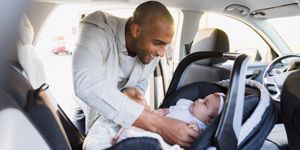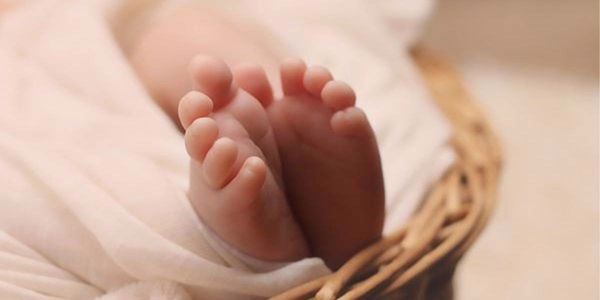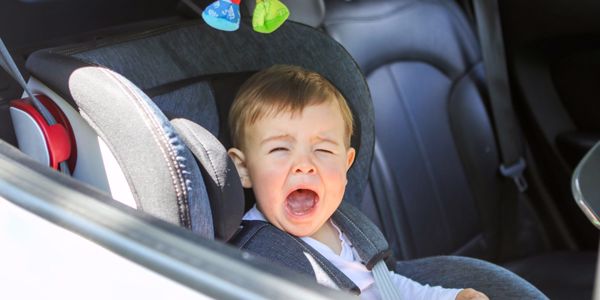Are you feeling confused about all of the different safety aspects and things to think about when shopping for your baby's car seat? We've got you covered.
Here, we run through the basics of car seat safety, explain some of the car seat jargon, and answer some of the most-asked questions on car seat safety.
What Are i-Size Car Seats?
I-Size car seats are a part of the R129 regulation for car seat safety. Introduced in 2013, regulation ECE R129 was largely brought in to make parents' lives easier and clarify when children should be moved onto a new seat or facing a different direction.
Since it was brought in, ECE R129 has been in place alongside the existing ECE R44, and car seats have been able to be manufactured and sold, provided that they pass either of the two safety standards.
From 1st September 2023, ECE R129 will become the sole standard approved by authorities. This means that EU and UK authorities will no longer accept R44 approvals, except for built-in boosters.
Still, these new rules apply only to manufacturing and selling new R44 car seats. In September 2024, you won't be able to purchase R44 car seats, but there's still no set plans to ban their use of them.
Is Isofix Safer Than a Seatbelt?
When installing a car seat for your little one, you have two options: using the car's seatbelt or the ISOFIX system. So, which is better?
The ISOFIX system is a set of hooks that attach the car seat directly to the car's frame. This is super handy because you don't have to mess around with seatbelts, and it tends to be more secure overall. Plus, it reduces the chances of you screwing up the installation and doing it wrong.
Still, using a seatbelt to secure a car seat is a tried-and-true method that has been used for decades. Using the seatbelt, you thread the belt through the seat and tighten it to keep it in place. And you can use this method in any car that has seat belts.
Recent ratings have revealed that ISOFIX child car seats are not necessarily safer than the traditional seat belt-retaining system. Many parents find ISOFIX much easier to use than seatbelts, as you simply have to plug the Isofix connectors into the anchor points on your car's back seats.
Whichever method you plan to use, the most important thing is to carefully read the car seat and vehicle owner's manuals and follow the instructions for installation carefully.
Rear-Facing vs Forward-Facing Car Seats
While forward-facing car seats have been the norm in the past, and it's most likely what our parents used with us as children, it is now the minimum recommendation for rear-facing car seats to be used for little ones until at least the time they turn two, but it is preferred that children remain rear-facing until they are at least four, or six if possible while they are still strapped in with a harness, then they would then move into a high backed booster.
In a rear-facing car seat, your baby sits facing the back, while your car's backrest supports the car seat. Rear-facing car seats are designed to protect babies from head and spinal injuries, which can be fatal in the event of a crash.
Babies' heads are known for being big, but you might not know that your little one's head accounts for 25% of their body weight, compared to an adult's 6%. This puts them at a much higher risk of head and neck injuries in an accident.
During an impact, a rear-facing car seat cradles the baby's head, neck, and spine and distributes the force of the impact over a larger area. This helps to prevent serious injuries that could occur in a forward-facing car seat. Children and babies who are properly secured and rear-facing often sustain no injuries as rear facing reduces the risk of injury and death by 90%!
When Do Babies Move Up From Their Newborn Car Seat to the Next Stage?
The time at which your little one will move out of their newborn car seat to the next stage will depend on whether you're using a seat that's sold by weight and size, or an i-Size seat that's sold based on height and age.
If you're using a Group 0 or 0+ seat that's based on weight categories, your baby should move up to the next stage seat when they weigh more than the maximum limit for the seat, or when the top of their head is level with the top of the seat.
Your baby should be rear-facing in their car seat for as long as possible, and most group 0+ car seats are suitable for up to 13kg. When height-based or i-Size car seats are used, the child must travel rear-facing until they reach the age of 15 months.
Still, depending on the size of your baby, and when the top of their head reaches the top of the seat, many babies stay rear-facing until age 3 or 4.
Fixed vs 360-Swivel Car Seats
Many of the most popular car seat models are now 360 swivel car seats, rather than the traditional fixed seat design. These car seats are designed to rotate all the way around, making getting your child in and out of the car much more straightforward. This is particularly useful for parents with back problems or mobility issues or when you've got your hands full with shopping or other things.
With 360 swivel car seats, the added bonus is that you can use them in rear-facing and forward-facing positions, which can offer flexibility as your child grows.
Fixed car seats are the cheaper option and are typically way easier to install and use. But the downside is that they can be tricky to use, and getting your little one in and out can be awkward, especially if your car's on the small side.
How Reclined Does My Baby Need to Be in a Car Seat?
The best recline angle for your little one will depend on how old and big they are, and the type of car seat you're using.
For safety and comfort reasons, newborns should be reclined to around 40-45 degrees. As they grow and get better at supporting their own head, you can move the car seat into a more upright position of around 30 degrees.
When adjusting the recline angle of your baby's car seat, it's essential to always follow the instructions for your specific seat, as well as any particular recommendations for the age and weight of the child.
Is a 5-Point Harness Car Seat Better Than a 3-Point One?
A 3-point and 5-point harness have the same job, to hold your baby in their seat securely. A 3-point harness consists of two shoulder straps and a waist strap. The straps come together to buckle at the baby's crotch. This type of harness is commonly used in car seats designed to grow with the child.
While a 3-point harness does provide some protection, it leaves the child's torso and upper body relatively unprotected. A 5-point harness offers two additional straps that secure the child's shoulders. This type of harness is more common in infant-specific car seats and is considered the safest option. The two shoulder straps provide extra protection for your baby's upper body and reduce the risk of them being ejected from the seat in an accident.
What Are Side Impact Wings on a Car Seat?
Side impact protection, often in cushioned side wings and headrests, is an added safety feature found in some baby car seats. These features work together to absorb and distribute the impact of any crash away from the baby's body, reducing the risk of injury.
Side impact protection is something to look out for when choosing a car seat for your little one, and is a welcomed additional source of protection.
How to Check if a Car Seat Is Compatible With Your Car Model
While there are a lot of fantastic car seats out there, one thing that surprises a lot of new parents is that not all car seats are compatible with all car models. Choosing the right car seat for your baby is a huge decision, and ensuring that it's compatible with your car model is vital for keeping your little one safe.
Here are some steps you can take to check if a baby car seat is compatible with your car:
- Read the car seat manual: The manual should tell you which car models it's compatible with. So, look and see if your car is on the list.
- Check for the ISOFIX system:Most modern cars are equipped with the ISOFIX system for securing car seats. Ensure your car seat comes with the system and your vehicle has the corresponding anchors.
- Check for the seat belt system: If your car is older or doesn't have the ISOFIX system, you'll want to see if the car seat is compatible with your car's seat belt system. Make sure it will be secure.
- Try out the car seat in your car: Before you buy a car seat, see if it fits in your car and can be installed properly. You can always ask a certified car seat technician to double-check for you if you need more clarification.
Baby Car Seat Accessories
Various accessories available in the market can enhance the comfort and safety of a baby in a car seat, and many seats come with a range of accessories as optional extras. While they definitely shouldn't sway your decision on choosing a car seat, and safety should always be the deciding factor, it's not a bad idea to think about the accessories you might want beforehand.
Here are some popular baby car seat accessories:
- Car Seat Covers - These are designed to fit over the car seat, protecting it from spills, stains, and the sun. Some covers have an opening at the top for easy access to the handle or baby, and others have a mesh panel for better ventilation.
- Head Supports - These are designed to provide extra support to a baby's head and neck, especially during the first few months when the baby's neck muscles are still developing. Head supports are usually soft, breathable fabric and can be easily attached to the car seat.
- Mirrors - Mirrors are an excellent accessory for parents who want to keep an eye on their baby while driving. These are attached to the back seat headrest, allowing parents to see the baby's face in the rearview mirror.
- Sun Shades - Sun shades are designed to block the sun's rays and keep the baby cool and comfortable. The shades can be attached to the car window using suction cups or clips and easily removed when not in use.
- Travel Trays - Travel trays are designed to provide a stable surface for your little one to play or eat on during long car journeys. These are usually made of sturdy plastic and have raised edges to prevent spills and messes.
- Strap Covers - Strap covers are designed to provide extra cushioning and prevent irritation from the car seat straps. These are usually made of soft fabric and can be easily attached to the straps using Velcro.
When Should I Remove the Newborn Insert From My Car Seat?
There's no escaping the fact that newborns are fragile little things! The newborn insert with your car seat will offer more padding and protection to keep them safe as they grow into the car seat.
Generally speaking, most car seat manufacturers recommend removing the newborn insert when your baby is between five and six months old. To be safe, you should always check the seat's manual, as it should specify a height or a weight to remove the newborn insert.
Car Seat Weight Groups Explained
To help parents out when choosing a car seat and knowing which are compatible with their baby's age and size, car seats are broken down into four different groups:
- Group 0, 0+ - Also known as infant carriers, these are safe for babies from birth to 13kg (0+), or 10kg (0). This is approximately 12 months.
- Group 1 - Children from 9kg to 18kg are suitable from around 9 months to 4 years.
- Group 2 - These are booster seats for children from 15kg upwards, which is approximately aged 4 onwards.
- Group 3 - Booster cushions for children 22kg upwards, approximately age 6 and more than 125cm tall.
Most car seats will grow with your child, also known as multi-stage (or Group 1-2-3) car seats. These seats are suitable for children from around 9 months up until 12 years, or 135cm when a car seat is no longer needed.
How Long Can a Newborn Be in a Car Seat?
It is generally recommended that newborns shouldn't be in a car seat for more than two hours at a time, as they are at risk of developing respiratory problems or positional asphyxia. This is because when they're in the newborn stage, your baby's airway is still developing, and their neck muscles aren't strong enough to support their head. Because of this, it's common for their chin to rest on their chest, restricting their breathing.
Keeping an infant in a car seat for an extended period can also cause pressure on their developing spine, leading to discomfort or injury. Therefore, taking frequent breaks during long car journeys is essential to allow the baby to move around and stretch their muscles.
When should I move from a car seat to a booster seat?
Booster seats, which fit into group 2 and group 3 of the above categories, are suitable for children from 15kg upward, usually around when they turn 4. Booster seats can offer great protection for your child, but it's still important to shop around and find the one you feel is safest.
Many booster seats now have features designed to give side impact protection, as well as adjustable backs to last your child until they no longer need a car seat.
How Much Should I Spend on a Car Seat?
As with most products, there is a vast range of price points when buying a car seat. You might be able to find a car seat for around £30, and for some of the top-end seats, you're looking at around £500.
While you certainly don't need to spend hundreds of pounds on a car seat, finding a good seat that's been properly crash-tested and deemed a safe option is important. Do your research before choosing a particular seat or brand, read as many reviews as possible, and check out the safety rating compared to other car seats.
For more information on what to look for, check out these important things to remember when buying a car seat. Or, for more safety information, see our guide on driving with a newborn.






